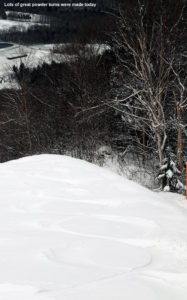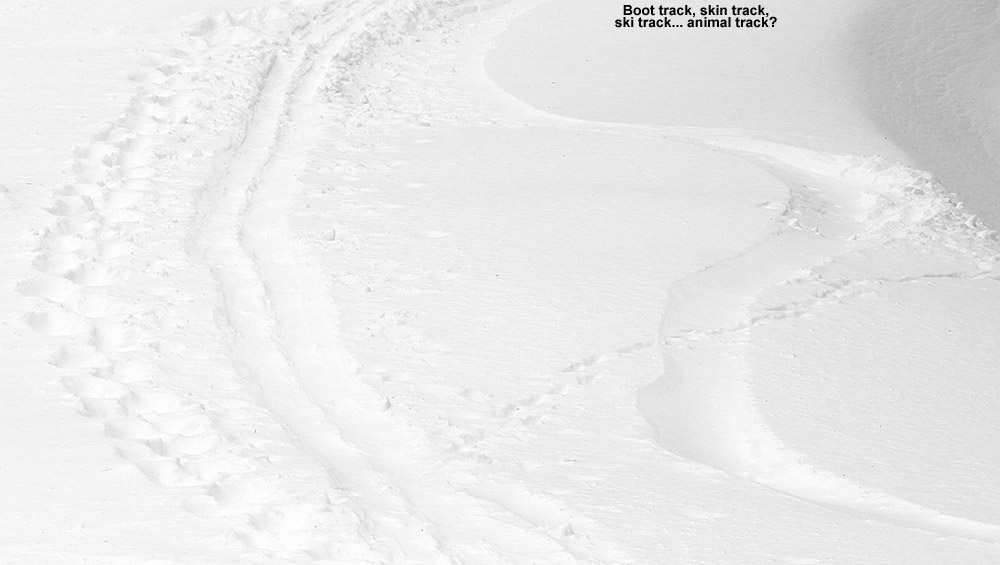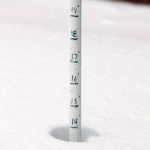
It’s not every May that we get great powder to ski, but this May will certainly go down as one in which we did. The potential for snow from this current storm cycle has been on people’s minds since last week, so it certainly wasn’t a surprise, but of course you never know exactly how things will play out until they actually get going. For me, it was pretty obvious that things were going OK when we were picking up frozen precipitation all the way down in the valley during the day yesterday. Reports of accumulating snow were already coming in from the mountains as well. Then, late last night we began to get some legitimate snow at our house, and it was obvious that the local mountains were going to continue with accumulations.
 Snow was still falling at the house this morning, and if anything it was becoming drier as time went on, so that was encouraging. I decided to head out to Stowe as planned, and I brought along a bunch of camera gear because I expected there would be some fun photo ops along the way. As I traveled to Mt. Mansfield, it was clear that the lower mountain valleys in the 500’ to 1,000’ elevation range were right around the snow line, and that produced a fantastic amalgam of snow accumulations and touches of spring greenery. Aspect wasn’t too critical in determining accumulations since it was quite cloudy, but the type of surface and whether or not it was elevated really played a big role. Also, you could travel just a few hundred yards and see quite a variety of accumulations depending on which areas had been hit with heavier snow showers. Some yards had snow on the grass, some had accumulations only on elevated surfaces, and some had neither. In some spots only the rooves, or just sections of the rooves, held accumulations. The precipitation I encountered was all snow, but temperatures were generally in the mid 30s F, so that contributed to the variable accumulations.
Snow was still falling at the house this morning, and if anything it was becoming drier as time went on, so that was encouraging. I decided to head out to Stowe as planned, and I brought along a bunch of camera gear because I expected there would be some fun photo ops along the way. As I traveled to Mt. Mansfield, it was clear that the lower mountain valleys in the 500’ to 1,000’ elevation range were right around the snow line, and that produced a fantastic amalgam of snow accumulations and touches of spring greenery. Aspect wasn’t too critical in determining accumulations since it was quite cloudy, but the type of surface and whether or not it was elevated really played a big role. Also, you could travel just a few hundred yards and see quite a variety of accumulations depending on which areas had been hit with heavier snow showers. Some yards had snow on the grass, some had accumulations only on elevated surfaces, and some had neither. In some spots only the rooves, or just sections of the rooves, held accumulations. The precipitation I encountered was all snow, but temperatures were generally in the mid 30s F, so that contributed to the variable accumulations.

Fairly continuous coverage on the ground really started once you got above 1,000’ in elevation, and up around 1,600’ at the Midway Lodge I found roughly an inch of accumulation. My initial plans were to skin up Nosedive, since it’s always a good late-season bet, but from what I could see, the snow depth really didn’t jump up that quickly with respect to elevation. With that in mind, I headed along Crossover toward the main North Slope route to hopefully find solid base coverage down to lower elevations. The coverage on Crossover wasn’t quite enough to make skinning worth it, so I hiked along until I caught North Slope at around 1,800’ or so, where I was able to start skinning. Indeed the snow depth was building slowly, as even at roughly the 2,000’ mark there was still only 1”-2” of new snow.
I was starting to think that I was going to be out for more of a hike than a real quality powder skiing session, when suddenly I got up around 2,500’ and the snow depth really began to jump up. Here’s my best estimates of new snow depth based on measurement pole probing along my route:
1,600’: 1”
2,000’: 1”-2”
2,500’: 4”-6”
3,000’: 7”-8”
3,600’: 8”?
I didn’t really detect any notable gains in snow depth between 3,000’ and 3,600’, and the stronger winds made the measurements more challenging anyway, but my best guess was around 8” up at the Octagon.
 I stuck my pole right in the snow by the main Octagon doorway and found 14” – this was clearly due to some drifting, but that’s a decent idea of what you could find if you were hitting the deeper spots along the trails in the upper elevations. The winds were nice in some respects though – they had erased most tracks from previous skiers without really hammering the powder. For the most part it was a gentle sifting in of new snow without any formation of wind crust. You could certainly see signs of old tracks in various locations, but in many cases the trails had been wiped clean, wall to wall.
I stuck my pole right in the snow by the main Octagon doorway and found 14” – this was clearly due to some drifting, but that’s a decent idea of what you could find if you were hitting the deeper spots along the trails in the upper elevations. The winds were nice in some respects though – they had erased most tracks from previous skiers without really hammering the powder. For the most part it was a gentle sifting in of new snow without any formation of wind crust. You could certainly see signs of old tracks in various locations, but in many cases the trails had been wiped clean, wall to wall.
“…those turns above 2,500’ would have held up as high quality in any season.”
Anyway, that top ~1,000’ of vertical offered up simply fabulous turns – the powder was mid to heavy weight, but not sticky at all and it had plenty of buoyancy to keep things bottomless right down to 2,500’ as long as you followed the deposition patterns along the trails appropriately. I had decent turns back down to 1,800’ at Crossover, but they generally weren’t bottomless down there – laps above 2,500’ were the way to go depending on one’s time and how they set up their tour. You’d have consistently very high quality turns with that approach. The turns for me were clearly some of the highest quality I encountered this season, and certainly some of the most consistent at such a high level. Granted, we know how this season went with regard to blowing away the record books on the low end, but those turns above 2,500’ would have held up as high quality in any season. I had debated bringing my mid-fats today since I was unsure of how the accumulations were going to play out, but there was no question after my run – the fat skis were totally in their element and delivering just like they should.









